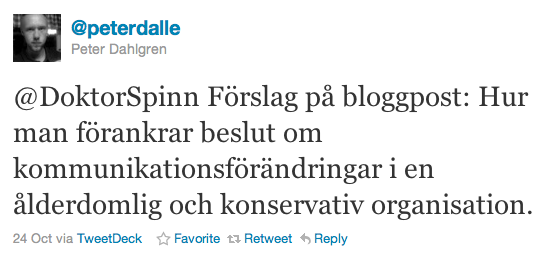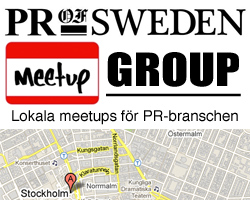Translation: @DoktorSpinn Suggested blog post: How do you anchor decisions on communication changes in an old-fashioned and conservative organization?
As we have entered the era of two-way digital conversations, I think this is a key concern for anyone working with communication strategically. I’ve summarized my experiences working with conservative organizations from five different perspectives, Acceptance - Openness - Patience - Intelligence - Respect. I call them the five virtues of change communications.
Acceptance
a) The Public Ones: Often times when I meet the public sector organizations, there’s a huge lack of confidence amongst them. I often hear them say that they are so far behind, but I don’t think that’s necessarily true. The public sector might move slowly, but the spirit in the organization is to serve democracy, transparency and public interest. It’s not primarily about profit, and this is somewhat of an advantage when it comes to being successful in social media endeavors.
b) The Trendy: When it comes to privately held companies, there’s a little bit of everything. Some are into social media because their brand equity sort of demands it. They have to keep up in order to keep trendy. So they do attention-grabbing stuff primarily.
c) The Profiteers: Some companies simply want to be sure about ROI first, a fully understandable approach but hazardous in any relationship. The mentality “we-can-be-friends-with-you-only-if-you-agree-to-buy-something-first” is sometimes misleading companies to do all the right things wrong in social media.
d) The Marketeers: Others are enthusiastic from a marketing standpoint. They see an explosion of vibrant channels where they can push their corporate messages. They always wonder how to push more, push better. Push, push, push. Pull? “Well, we already do a lots of influential marketing!”
e) The Volume-Seekers: Another category is the e-commerce based companies. They are often tech-savvy and down with the whole social media thing. They crunch their numbers and finds that they need one thing, more volume. Double the volume, double the sales. Also a difficult approach to social media.
f) The Professionals: Then we have the truly professional organizations. They have difficulties as well. Because IT are concerned about security - it’s their job. HR is concerned about integrity - it’s their job. Marketing is concerned about responsibilities - it’s their job. Legal is concerned about things being liable - it’s their job. And customer service are concerned about resources - it’s their job. Management is concerned about agreeing to the right things in a changing business environment - it’s their job. It’s not easy being a human being engaging with another human being in complex corporate environments.
f) The Accidental Tourists: We also have those who are forced to engage with social media in some way or another. Often times these companies have experienced being digitally criticized or even hurt financially by having people talking about them. These companies are often traditional companies, but being forced to deal with their perception by listening and being humble is actually quite a good way to get into doing the right things from the start.
So, the playing field is actually quite even. The challenges lies primarily in what kind of organization you are working for. Understanding the organization itself is therefore more important than understanding all the facets of the social web.
2. Openness
There’s this myth that social media is all about engaging in conversation. But it’s not true. Think of Facebook. Most of us would agree that they are doing pretty well in social media. But not by engaging in online conversations; what Facebook does so well is that they listen. They look at what drives engagement and what doesn’t. And then they change - constantly.
Or look at Google. They basically know everything about us, but often have you engaged in an online conversation with someone of authority working at Google? What Google does so well is the listening part. They listen and they crunch their data and this gives them enough evidence to spend as much as they do on constant innovation. By listening they understand how important it is for them to evolve in order to keep themselves relevant.
Or Apple. Do you see them engaging in conversations? Not much relative to their size, their brand recognition level, or their fans engagement. But they do monitor social media carefully. Apple “thinks differently” in that they are building machines for humans, not for leveraging new technology. So, they are focusing in on us humans instead of bragging about GHz.
However old-fashioned an organization are - I haven’t yet met a CEO who haven’t understood the gravity of the situation when presented carefully analyzed social media data from monitoring. It’s pure business intelligence from the world’s largest and most honest focus group; ignoring these findings is like saying “no” to better and more well-informed decision-making in basically all aspects of modern business.
3. Patience
Many old-fashioned and bureaucratic organizations have all gotten the same advice more than once - “it’s all about jumping into the cold water”. This is immature advice for serious business. It’s true that there is a first-mover advantage to social media. It’s true that understanding comes from becoming an active part of the social eco-system. But it’s equally true that poor social media management is a pure waste of money, and it might even hurt the organization - badly.
There are no shortcuts in this. If you’re an social media enthusiast working in an old-fashioned industry, your passion might actually get in the way of what you need to do. Because you need to facilitate a change process that affects the whole organization. The transparency- and engagement process is affecting the organization in a profound way and anyone taking this on needs to respect the toll it takes. It’s not like launching an aggressive marketing campaign with glossy copy and then to be done with it.
If anything, use your passion to fuel your patience.
I know many organizations engage in experimental social media activities in order to show the ones who aren’t convinced the results in order to turn them into believers. This is one strategy, of course. And sometimes it works. But just as often it backfires - building trust and relationships in digital arenas takes time and corporate longevity. Sometimes taking a calculated risk in order to manifest a business case is the right way to go, but how can the risk be calculated if you haven’t based your idea on some sort of intelligence?
4. Intelligence
There’s an abundance of monitoring tools available. It’s exciting and a great development. But there’s a great difference between listening to people - or actually hearing them. It’s what you do with the information that matters. It’s how you construct your strategies based on what you hear that matters. A strategy is a chosen pathway, but you can still chose the wrong path.
It’s the intelligence of human beings that makes the difference. Even if you are using the most expensive and sophisticated monitoring tools out there, it’s no guarantee for successful business operations implementation. A singular sharp brain and a set of free Google tools can still put together a strategy that will change the game you’re in.
This is the reason why hiring a social media manager is one way for old-fashioned companies to accelerate the change process. It’s a though and lonely job most of the time and it requires a solid set of patience, people skills, and organizational understanding, but investing in a singular brain is often far more effective than investing in tools, channels, or campaigns.
5. Respect
For anyone struggling with change management, I would recommend the modern fable Our Iceberg Is Melting: Changing and Succeeding Under Any Conditions by John Kotter. It’s a story about a penguin colony where one day a single penguin individual discovers that the colony’s icy home is melting from within - fast. The penguin tells the colony exactly what he has found, but no-one listens to him. Why?
For one thing, the penguin individual isn’t part of the dominant coalition to start with. Plus, as he is a curious and somewhat impulsive individual, he is simply the sort of type who would cry wolf at any sign of potential drama. For another thing - the iceberg is all the colony know. It’s basically their entire world, leaving it would be scary and might mean death for a lot of fellow penguins.
So the penguin who discovered the need for change simply couldn’t get his message across himself. Instead, the news of the discovery starts a complex process of fear and politics. And this is what this fable is about.
My point is that you must respect that change affects people and that it isn’t a linear process based on logic. People need to know what they need to know in order to embrace change. And what you need to know isn’t necessarily the same as what others individuals need to know. Some need to understand how the challenges should be overwon. Some need to weigh the pros and cons. Some needs to know what’s in it for them personally. Others are just plain scared or in need af a new vision.
Related:
- Two Levels of Change
- John Kotter’s 8 Steps of Leading Change
Related articles
- Most Marketers Plan to Increase Social Media Spend This Year. Still Getting It Wrong. (ianschafer.com)
- The social media summer survival guide for #PR pros (higher-and-higher.com)
- 8 ways to beat social media skepticism in regulated industries (justincaseyouwerewondering.com)
- Social Business Readiness: 5 Questions for Legal Executives (leadernetworks.com)
- Social Media Insecurity? Try Our Maturity Model Prescription (leadernetworks.com)
- How do you sell engagement to execs who don’t already believe in it? (justincaseyouwerewondering.com)



 Like Doktor Spinn on Facebook
Like Doktor Spinn on Facebook Connect With Jerry Silfwer on LinkedIn
Connect With Jerry Silfwer on LinkedIn Subscribe to Blog via E-mail
Subscribe to Blog via E-mail Follow @DoktorSpinn on Twitter
Follow @DoktorSpinn on Twitter




